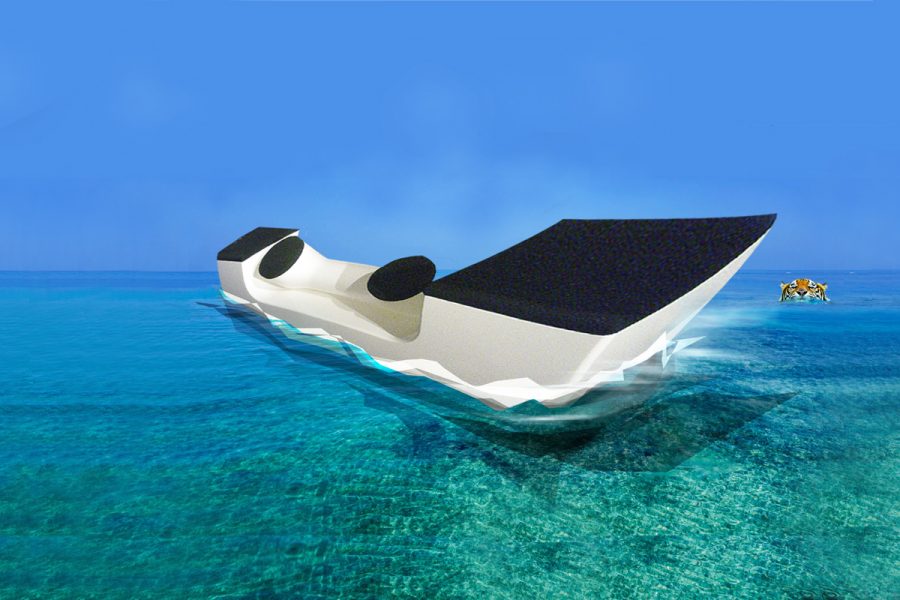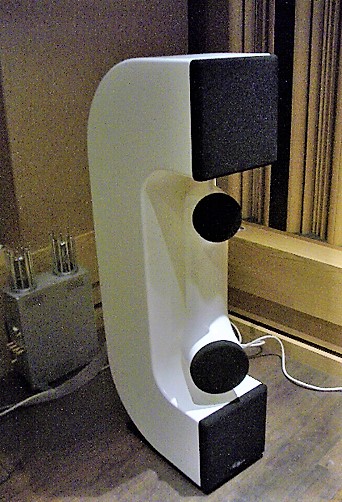 Have this loudspeaker ever appeared in a film? If not, it should have. It would have been a perfect stage furniture eg. for some avant-garde movies from the second half of the 20th century. The speaker has, in its appearance, at the same time a glint of science fiction, anachronistic futurism and innocent 1960s decadence and optimism.
Have this loudspeaker ever appeared in a film? If not, it should have. It would have been a perfect stage furniture eg. for some avant-garde movies from the second half of the 20th century. The speaker has, in its appearance, at the same time a glint of science fiction, anachronistic futurism and innocent 1960s decadence and optimism.
The Synthese was designed in the 70s, and published in the early 80s. According to a source, in 1981. Perhaps that too tells about its character: it looks ten fifteen twenty years older, while breathing modern universalism, or universal modernism, if you like.
The speaker appears to be still in production judging from the fact that the (rather elementary) website exists, but whether it’s been manufactured without breaks all these three decades, I have no idea. Its provenance is in Belgium. The name of the company is Floating Systems, and the master-mind/designer behind the speaker is Ivan Schellekens.
Here’s his brief bio from the website:
“Born in 1945 in a little village near to Antwerp, in Belgium, Ivan Schellekens, was fascinated by electronics and hi-fidelity already in his childhood. At the age of 13 he realised his first hifi-stereo-loudspeakers. This was the start for a long career as a hifi-specialist. After his studies as electronic engineer he first worked as a consultant in room-acoustics, but then in the 70’s begun to develop home-speakers having always felt a profound respect for a natural sound reproduction. His goal for a speaker-reproduction ‘as natural as music itself’ was born at an organ-concert with soprano-accompaniment in a cathedral where the voices stood totally free from the organ music!”
Floating Systems currently sports two speaker series: the more recent Floating Cameleon and the topic of today: Floating Syhthese. Of the latter, two versions exist: the four-way Synthese 1 and the updated 3-way Synthese 2. In the past, there was the third mini-Synthese.
The 10000 euro review object (around 2010, not sure what the current price is), Synthese 2, looks delightfully weird, distinctive and sculptured. In fact, it looks more balanced and harmonious than the bigger brother. Apart from the outlooks, it’s a quite a case technically too.
First off, the three-way is a transmissionliner! As we all know, to be effective the line of the TL cabinet needs to be sufficiently long. To achieve the goal Schellekens has designed C-profile cabinet for the 21cm Vifa woofer, and managed to achieve 137 cm line length. The heavily damped bass part reproduces frequncies below 250Hz.
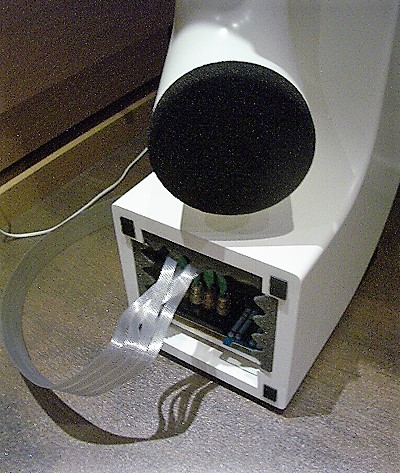 The woofer is placed at the upper end of the C profile cabinet, while the bottom part hides the adjustable crossover. I don’t know the exact reason for the woofer placement. Sometimes the woofer is placed close to the floor to get rid of the floor reflection suck out. Perhaps, the woofer half a meter higher up than “normally” means that the floor reflected sounds around 200-250Hz reach the listener sufficiently long after the direct sound, and thus are less detrimental to the ear?
The woofer is placed at the upper end of the C profile cabinet, while the bottom part hides the adjustable crossover. I don’t know the exact reason for the woofer placement. Sometimes the woofer is placed close to the floor to get rid of the floor reflection suck out. Perhaps, the woofer half a meter higher up than “normally” means that the floor reflected sounds around 200-250Hz reach the listener sufficiently long after the direct sound, and thus are less detrimental to the ear?
On the other hand, the woofer at that height may mean that it is prone to easier excite room modes particularly between the floor and the ceiling, than would be the case normally, but this is only speculation, and depends naturally on the floor/ceiling distance.
Another trademark of the Synthese speakers is the pivotal column or pillar, made of a composite material, between the C’s ends. It houses a Seas textile dome at one end, and the Seas midrange (MC11fc/H143) driver at the other lower end of C-bent cabinet. The units are crossed at 3200 Hz // 5000Hz ???? Why this construction?
Two reasons: the designer firmly believes that acoustically disconnecting the tweeter and the midrange units from the sub/woofer enclosure is largely beneficial to the sound. That’s why the middle-columm is freely suspended. To the same effect the column is filled with a high-density material.
Floating Systems is of course not the first or only speaker manufacturer who swears by the principle of mechanically disconnecting the tweeter, and less often the midrange driver, from the woofer section eg. to avoid cabinet vibrations causing ‘intermodulation’ distortion. In fact, it might be harder to mention speakers, in which the matter had not been addressed, at least on a paper, than those in which it has. But does disconnecting really make a difference? For some it does, for others less. Seen from the tweeter’s perspective one might argue that the vibrating cone of the nearby woofer poses a much greater threat to the tweeters operation than the resonating speaker cabinet. But this hardly is the case with the Synthese 2.
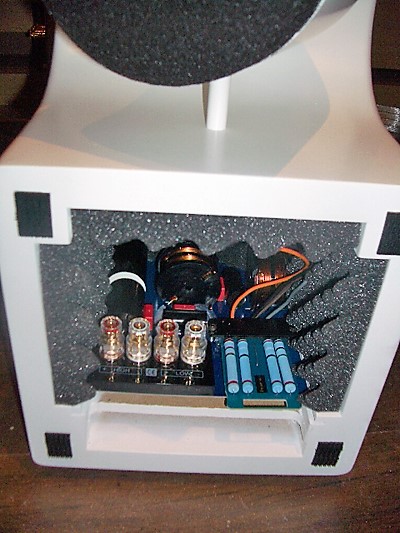 The second argument for the freely rotating middle tweeter/midrange column is that it allows the listener to finetune imaging characteristics and optimize the soundstage. The manufacturer recommends directing the tweeter/midrange driver column so that the beams cross in front of the listener. Angling of the column in such a way can add livelihood to some ‘dry’ recordings. It may also enlarge the hot spot, ie. the area of the best sound. But most importantly, the fact that the column can be steplessly rotated means that their position can be precisely locked where it brings about the best end results in terms of the soundstage and imaging. This requires that the response is horizontally fairly even and smooth across the frequencies (ie. not too directive).
The second argument for the freely rotating middle tweeter/midrange column is that it allows the listener to finetune imaging characteristics and optimize the soundstage. The manufacturer recommends directing the tweeter/midrange driver column so that the beams cross in front of the listener. Angling of the column in such a way can add livelihood to some ‘dry’ recordings. It may also enlarge the hot spot, ie. the area of the best sound. But most importantly, the fact that the column can be steplessly rotated means that their position can be precisely locked where it brings about the best end results in terms of the soundstage and imaging. This requires that the response is horizontally fairly even and smooth across the frequencies (ie. not too directive).
Rotating the column also changes the tone of the sound (tonal balance) by increasing or decreasing the amount HF in the totality of the sound. However, the principal way in which the tone of the Synthese 2 can be adjusted is by inserting small electronic boards (four different exist) in the crossover board at the bottom end of the speaker. The EQ cards affect the midrange and the treble, not the bass.
The bi-wire speaker terminals too are hidden behind the bottom grill, directly assembled onto the internal PCB. The cables can be routed through a shallow opening behind the speaker.
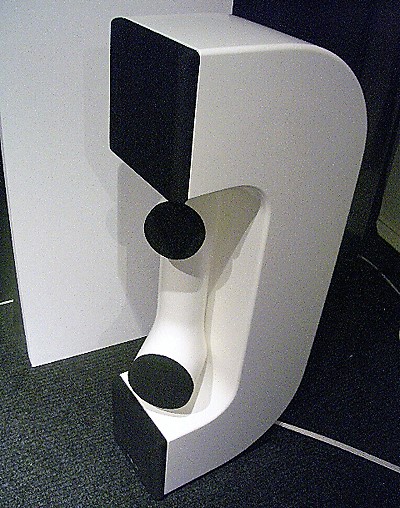
Huge sound
I had a chance to listen to these speakers in two different rooms, first in a shallow one with Parasound amplification, and then in a SMT Level 3 treated listening room with Hegel’s top end electronics. There was a quality in the sound that that I’ve never quite come across before. Hard to describe what the quality was though. Perhaps it could be called “foreign to mainstream hi-fi” but it also could be described as “analogue”. By that I mean that the speaker sounded “concrete” in a way turntables tend to do if compared to CD players. This characteristic, not as dramatic as it may sound, was related to some kind of innocent openness of the sound, which made the speaker overall quite pleasant to listen to. The sensitivity is around 90 dB but the speaker sounds as if it were more sensitive.
In the first mentioned locality the bass was uneven almost to the point of rendering the evaluation impossible. That was mainly due to the room shape, stone walls, the fact that there was no acoustic treatment whatsoever. In the well treated SMT room the bass performance was much more correct, but perfect it wasn’t this time either (ie. it clearly colored some music samples). I think the speaker needs lots of volume and space and taller rooms. The woofer almost in the mid-way between the floor and the ceiling meant that the speaker probably participated in exciting the vertical room mode somewhere between 100-200 Hz.
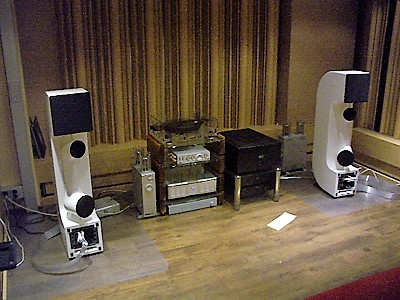
The other thing is that the bass really goes down; the manufacturer declares the –3dB point as 26 Hz, and – 2,5dB point 30 Hz. On the basis of the listening tests, the figures are not much exaggerated. The listening room, even though equipped with bass traps still has some problems at these frequencies with speakers that descend down enough, meaning that full range speakers such as the Synthese 2 can produce problems in the bass that other speakers do not suffer from. Despite the varied performance, the bass of the Synthese 2 when not too excessive had a very interesting, realistic tone. The manufacturer claims that the Synthese 2 is an easy cake with respect to placement, and just recommends keeping the speaker far from the walls. I’d say the placement requires more attention than that.
The midrange and the treble performance was fairly smooth and clear with no obvious ear-piercing anomalies. No doubt I have heard more sophisticated and brilliant, less “old-style” treble performances, but that didn’t bother me during the critical listening sessions, and the reason is that despite the tone the HF and the midrange reproduction eg. in terms of instrumental timbres were mostly correct. The phase behavior between the tweeter and the midrange unit seems to be correct.
One of the niceties of the sound, in addition to its analogue nature, was the huge and tangible soundstage, not typical hi-fi, not speaker-like. That combined with dynamically quite effortless performance made the sound quite appealing in its own idiosyncratic way. And rotating the center column works. Finding the exact angles of the columns can lock the sound sources within the soundstage quite effectively.
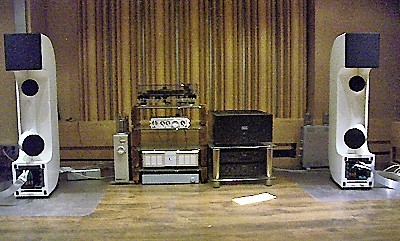 Worth 10000 euros? One, this is not just another ported floorstander with 3 or 4 dynamic elements: there’s some real technical effort behind these speakers. Two, there are elements in the sound that clearly speak for an affirmative answer, although in some areas a better performance can be achieved with a more modest investment. As always. Third, the Synthese 2 has a great although peculiar looks. It looks bizarre but in the most positive way. The finishing could have a more luxurious touch though.
Worth 10000 euros? One, this is not just another ported floorstander with 3 or 4 dynamic elements: there’s some real technical effort behind these speakers. Two, there are elements in the sound that clearly speak for an affirmative answer, although in some areas a better performance can be achieved with a more modest investment. As always. Third, the Synthese 2 has a great although peculiar looks. It looks bizarre but in the most positive way. The finishing could have a more luxurious touch though.
The Floating Synthese 2 may not be a speaker for everybody but for some its sound, great adjustability and looks just suits perfectly.
The opening image by Soila Kyppö.
Specifications: sensitivity= 88 dB –> 90dB; 8 Ohm resistance; frequency response 25 – 25.000 Hz, crossover frequencies 250 Hz & 5000 Hz.
With specific music samples
The music making ability of the Synthese 2 was “tested” with specific music samples collected from the Nouvelle Revue Du Son and Opus3 Test-CDs. The purpose of these samples is to function as a more or less accurate indicator of some specific aspect of the sound. But rather than leaving the story there, it is then assessed what the sound does to the music. Obviously, the upshot cannot always be attributed solely to the speaker: electronics and the room definitely have their finger in it too.
1. Tonal balance
In the ballad ”Tiden bara går” (from ”Levande” Opus3, No.7917) the voice of Thérèse Juelin must be clearly distinct from the background sound created by the double bass, guitars, bongos and triangle, and from the room echoes caused by the instruments. The ballad changes its character completely if the sound is tonally unbalanced or the broad frequency bands are not in tune with each other, which is what happens if, for example, the bass and the bongos dominate the whole.
Synthese 2: A bit ambivalent performance. The female voice is basically correct, ie. not overly masked by the bass, but the overall balance is still rather warm and soft. Occasionally the lower bass is unsystematic with the rest. The whole presentation could have more light, and been brighter. It would have given the music more rythm and speed. For the most part the performance is fine.
2. Bass performance
(a) In this piece of folk music “Unca’s Flight” (from KNOA: ”A Selection from KNOA”, Opus3 No. 8078), the double bass played with a bow must be reproduced sharply and gruffly, and should not sound boringly round.
Synthese 2: To some extent the bass line is illegible showing the problems of the interacting room. Not clear, nor too bad. Still somehow pleasant to listen. There’s certain openness in the bass and in the sound in general. The whole appeals. There’s livelyhood and life-likeness!
(b) Vivaldi’s sonata for cello and basso continuo (Accent ACC 9181D / NRDS No. 1): it is necessary that the cello and the double basses are reproduced with no coloration in order to maintain a right balance between the instruments.
Synthese 2: Not accurate enough, the location of the sound sources not at the best level, and again rather warm presentation pointing to energy reserves of the speaker at bass frequencies. Still there is something good about this way of sounding too.
3. Aggressiveness of the sound
(a) The Academy of Ancient Music’s recording on Purcell’s sonata No. 9 (L’Oiseau-Lyre 444620-2 / NRDS No. 6): accompanied by a viola and a small organ, the two violins mixed closely to each other prove ruthlessly what happens if the sound has any unduly harshness and aggressiveness, caused by the electronics, speaker or the room.
Synthese 2 (No 7): Quite good and pleasant, not hard, no harsh violins. Music springs beautifully.
(b) In Tomas Örnberg’s “Buddy Boldens Blues” (from the excellent Buddy Bolden Stomp –record; Tomas Örnberg, BLUE FIVE, Opus3 no. 7977): the trumpet must have a distinct horn character and sound sharp with never sounding shrill.
Synthese 2: Not aggressive at all. Clear yes, and not muted despite the room, could be a tad more edgy but otherwise possesses positiveness and exhilaration, openness, fluidity, and gentle forward-goingness fully serving the music. Nice!
4. Music’s dynamics
(a) In Alain Planes’ interpretations of Scubert’s impromptus (Harmonia Mundi HMC 901564 / NRDS No. 8): the dynamic variation between the subtle and the more powerful sections must be produced with all strength and forcefulness.
Synthese 2: Quite believable size piano. Effortless dynamics. Realism! Recorded space is conveyed superbly well. Here’s where big speakers excel. Some coloration, inaccuracies and extra energy in the lower midrange.
(b) The ability of the system to reproduce big dynamic punches can be tested with John Eliot Gardiner / Wien Philharmonics’ performance of Chabrier’s rhapsody for an orchestra (Suite pastorale, ”Espana”, D.G. 447751-2 / NRDS No. 8): even in the forte sections the timbres must not become distorted.
Synthese 2: The vertically big sound helps in reproducing music like this. The speaker sounds more sensitive than it actually is. On the surface the performance is lively and extrovert. No compression.
5. The attack, sustain and decay of notes
(a) Nigel North’s ”chitarron” – a luth – in Alessandro Piccinini’s ”Toccata XIII” (Arcana A 6 / NRDS No. 4): ought to be located just in the middle point between the speakers, the texture must be beautifully reproduced, and the bass notes must be light but expressive including the vibratos. The sounds coming from fiddling the strings should be reproduced realistically, not too softly, not too sharply, and the same applies to other low-level, extra-musical, non-harmonic sounds generated by fingers etc.
Synthese 2: Some extra energy on the lowest strings, not much. The speaker could be more careful with the timbres, although the performance is fine as it is. I liked that no signs of filtering were present.
(b) When soprano Catherine Bott sings, without standard vibrato, Purcell’s “Fairest Isle” from King Arthur (L’oiseau-Lyre 444620-2 / NRDS No. 6): it is important that the sustain and decay of the notes are reproduced precisely.
Synthese 2: –
6. Tone color – timbre
(a) Paul Badura-Skoda’s fortepiano as well as the accompanying violin, viola and cello in the background in Mozart’s quartetto (Arcana A 7 / NRDS No 2): mercilessly reveal the limitations of the system to reproduce correctly the tone color, timbre, of each instrument.
Synthese 2: Perhaps not the most correct presentation I’ve heard, but no big timbral mistakes or coloring either. Music sounds fine and attractive.
(b) The timbre of the violin and the harmonic richness of its tone has been recorded unexceptionally well in Henryk Szering’s Beethoven-recordings (Philips, 446†524-2 / NRDS No 8): and should become conveyed as such by the playback system. Also, the subtle decay of the highest sounds, low-level cabinet resonances as well as other fine details should be clearly audible.
Synthese 2: The violin is reproduced not masterly but nevertheless quite well and orthodox manner. The piano could sound clearer, more articulate though.
7. Confusion of sound sources
(a) The sample – Academy of St Martin in the Fields, S.N. Marriner conducting, plays Scarlatti/Avison: 12 Concerti Grossi (Philips 48806-2 / NRDS No 8) contains very complicated passages of orchestral music: the instruments should be heard and distinguished as separate instruments, irrespectively of how loud or softly each instrument is played/recorded.
Synthese 2: Lots of air around the instruments, imaging is fine. A quite clear presentation as to the location of the sound sources, although not the best performance in this regard. Some colorations.
(b) Stockholm Guitar Quartet playing J.S. Bach’s ”Invention No 14” (Opus3 No. 7810): the musical line of the custom-made acoustic bass guitar must stay clear from the other nylon string guitars, and despite the polyphony of the music, must have a very distinct tone, also during fast-moving passages.
Synthese 2: Again, a slightly smaller and more precisely portrayed sound would have helped in the defining but would then have lost a little from the impact. There is a slight risk of listening fatique here. Too much is happening at the same time.
8. Reproduction of low level signals
The sample of Telemann’s twelve fantasias for the nose flute (Globe Glo 5117 / NRDS No. 3) once again prooves how hard it can be to reproduce a wooden flute realistically and naturally: the low-level whistling sounds and similar sounds not directly linked to the music should be clearly audible but not as unpleasantly distorted hiss.
Synthese 2: –
9. The soundstage and the stereo image
(a) Vivaldi’s concerto for two mandolines (RV 532) playing side by side (New London Concort, P. Pickett, L’oiseau-Lyre 433198-2 / NRDS No. 4) can be used to assess the ability of the system/speakers to accurately locate sound sources on the horizontal axis, while the orchestra on the background provides a good indicator of the stability of the centre image.
Synthese 2: It’s here where the possibility to direct the centre column can be put to an effective use, and the most accurate stereo-presentation sideways searched and the locations of the instrument’s in the image locked.
(b) “Mille Regretz” (extrait) performed by Jordi Savall and Hesperion XXI (Carlos V, Mille Regretz, Aliavox AV 9824 / NRDS No. 16) provides an superbly rich test for many qualities of the sound, including properties of the stereo image, the accuracy of localization of the vocalists and the airy character of the sound in general.
Synthese 2: Again, some extra liveliness, slightly lame presentation as well. But quite a good whole. No major problems. Not as impressive as with some other samples but not bad either.
10. Spatial information
The slow movement (Andante) of Haydn’s string quartetto (Saulesco String Quartet, Opus3, CD 19520): if the system (electronics and the speakers) does not reproduce correctly the relationship between the direct and the reflected sound, music sounds woolly and vague, formless and obscure. When the echoes are reproduced with the right mutual proportion, they support the quartet’s delicate sound.
Synthese 2: Overall fine, perhaps more airy than accurate. The music sounded a little bit vague but not too much. One needs to be careful with the volume level.
11. Musicality 1: Rhytm and tempo
J.S. Bach’s concerto for two cembalos (BWV 1062, Veritas VC 5 45054-2 / NRDS No. 5) provides a highly illuminating example of how certain music does not permit any mental impression of the music proceeding too slowly with respect to what the music in point requires. The listener must be able to feel the rhythm and tempo of the performance right up to the listening seat. If feeling is that the music is dragging behind, Van Asperen’s and Gustav Leonhardt’s communication with each other and with the orchestra is broken.
Synthese 2: The sound is somewhat too big for the purpose. Same virtues and same vices as before.
12. Musicality 2: The overall color of the sound
There is a light-year difference whether Ivo Pogorelich’s interpretation of Mozart’s Fantasia KV 397 (DG 437763-2, NRDS No. 5) is reproduced with a system whose sound would be characterized as cold, grey and spiritless rather than with a system that permits Pogorelich’s playing to be conveyed with all its elegance and magnificence.
Synthese 2: It would have helped if the speaker would have kept things better under control, but realistic the sound is, forceful and dynamic, and in particular wide and spacious.
The second test-CD with other than classic music proved that the speaker works with lighter music as well, and that the speaker knows how to compromise between music styles.


